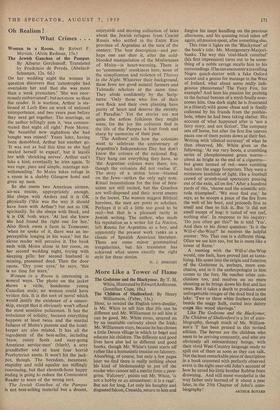More Like a Tower of Flame
The Godstone and the Blackymor. By T. H. White, illustrated by Edward Ardizzone. (Jonathan Cape, 18s.) HERE, to remind the English town-dweller, is Mr. White to tell him that life can be different and Mr. Williamson to tell him it can be good. Mr. White roves, spurred on by an insatiable curiosity about the Irish; Mr. Williamson stays, because he has chosen a little Devon village in which to beget and educate his children. The different and good lives have also led to different and good books, though Mr. White's latest starts off rather like a humanistic treatise on falconry. Absorbing, of course, but only a few pages later we find there is really nothing about his kind of birdsmanship to put off the reader who cannot tell a merlin from a pere- grine. 'Falconry', points out Mr. White, 'is not a hobby or an amusement: it is a rage'. But not for long. Let only his haughty and disgusted falcon, Cressida, return to him and forgive his inept handling on the previous afternoon, and his questing mind takes off again, all passion spent, after something else.
This time it lights on the `Blackymor' of the book's title: Mr. Montgomery-Marjori- banks. The way this 'coal-black cannibal' (his first impression) turns out to be some- thing of a noble savage recalls him to his surroundings. I f he can encounter a travelling Negro quack-doctor with a fake Oxford accent and a genius for massage in the West of Ireland, what about some really indi- genous phenomena? The Fairy Fire, for example? And here his passion for probing to the factual bottom of a myth finally over- comes him. One dark night he is frustrated in a (literal) wild goose chase and is finally collected by his friends from the poithin- hole, where he had been taking shelter. His account of what happened after is 'not a fairy story, and not fiction'. The company sets off home, but after the first few uneven paces one of them points down at their feet. Writing with 'clinical accuracy' of what he then observed, Mr. White gives us the following: 'At our very boots, a crumbling series of phosphorescent green worms— about as bright as the end of a cigarette— but green instead of red—were tumbling back into the soggy footprints. They were a miniature landslide of light, like a football crowd of crumb-sized spectators pouring out of the exits, all on fire.' After a hundred yards of this, 'shame and the scientific atti- tude triumphed'. 'We must find out,' he says, as he scoops a piece of the fire from the welt of his boot, and proceeds first to smell and then to lick it. But 'it did not smell except of bog: it tasted of wet turf, nothing else'. In response to his inquiry: `Do you often get this?' he is told 'Yes'. And then to his direct question: 'Is it the Will-o'-the-Wisp?' he receives the helpful answer: `No. That one is a different thing. Often we see him too, but he is more like a tower of flame.'
A meeting with the Will-o'-the-Wisp would, one feels, have proved just as tanta- lising. His quest into the origin and function of the Godstone is, perhaps, more con- clusive, and in it the anthropologist in him comes to the fore. He reaches other con- clusions too, and resolves on no more shooting as he brings down his first and last swan. But it takes a death to produce some unforgettable images of the dead bird in the lake: 'Two or three white feathers danced beside the soggy hulk, curled into dainty cusps like wood shavings.'
Like The Godstone and the Blackymor, The Children of Shallowford is a bit of auto- biography, though much of Mr. William- son's 'I' has been pruned in this revised edition. The heroes are the children who seem to be arriving constantly, and who are obviously all extraordinary beings, with their vivid West-Country language ready to spill out of them as soon as they can talk. Not the least remarkable piece of description in a book crammed with perfectly observed event is the eight-year-old John's account of how he saved his little brother Robbie from drowning. And still more wonderful is the way father only learned of it about a year later, in the 25th Chapter of John's auto-


























 Previous page
Previous page